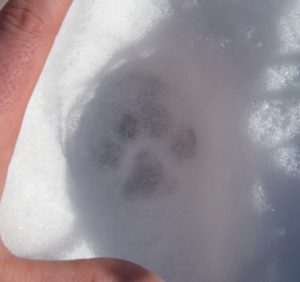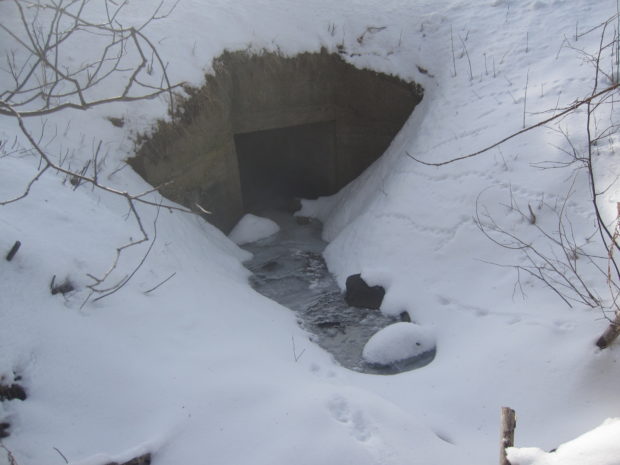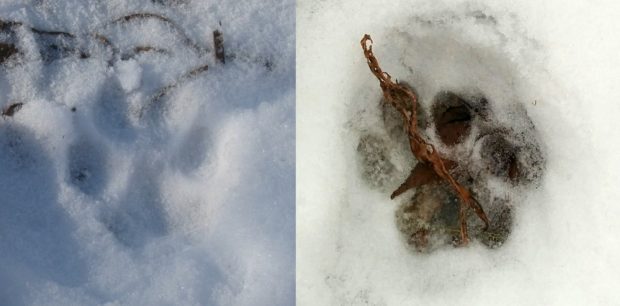We have much more to do and your continued support is needed now more than ever.
Searching for Signs of Winter
To many New Englanders, winter is defined in inches – inches of snow that is. By that account, you wouldn’t be surprised that winter has so far come as a disappointment to many, but especially to winter sport enthusiasts. Yes, New Englanders looked on with envy as mid-Atlantic states were recently hit heavy with multiple feet of snow; that illustrious powder.

With these ideal snow conditions, the National Wildlife Federation’s Northeast Regional Office has headed out with Northern Stewards to conduct tracking surveys at 24 sites throughout Vermont where the Climate Adaptation and Resilience Team is using wildlife cameras to document the movement of wildlife in proximity roadways. We are observing a fisher continually use a culvert in Glover, a bobcat that is ever-present in the Pomainville Wildlife Management Area in Pittsford, VT, coyotes, snowshoe hare, and much more.
Tracking surveys are often incorporated with wildlife camera monitoring to help reinforce the interpretation of wildlife movement and to mitigate against a camera’s potential to produce false negatives. For example, a camera may fail to detect a bobcat moving through the area, but while surveying the area we might find evidence of a bobcat via a track or sign.

Canine or Feline Tracks
A distinguishing feature of any canine, from coyote to fox to Yorkshire terrier, is that you can always draw an “X” through the features. The front two toes are evenly aligned and the entire print is nearly symmetrical. Unlike canines, feline tracks are asymmetrical. The front two toes are not aligned and one will be further forward than the other – similar to how we have one finger that is longer than the others.
On the other hand, a bobcat, leopard, or domestic cat – any species of the felidae family – will also always leave a track surrounded by a “hair halo.” On a perfect impression, you can also draw an “M” on the leading edge of the heel pad. Just remember, “M” for “Meow”!

Join the Action!
If you are interested in the chance to observe wildlife, I’m happy to inform you that you don’t need fancy equipment. You don’t even have to travel far! Wildlife tracking is a fun, interactive activity for all ages and can offer a whole new perspective on how you see and value the land around you. Best of all, you don’t need to be an expert – all you need is a little bit of curiosity and the right approach.
A Few Tips to Get Started:
- Get outside! The best time to observe wildlife is during the morning and evening hours.
- Shhhhhh, be quiet. It’s often easier to hear wildlife before you see it so try to remain as quite as possible.
- Stay downwind. Take notice of the way the wind is blowing and always try to face into the wind. Many animals have a keen sense of smell and standing upwind can quickly alter them of your presence. Try to also avoid wearing perfumes or other strong scents.
- Patience is virtue. Slow down and take the time to stop, listen, look, and wait. Make your self comfortable and settle in.
- Pick a good spot. Are you looking for a species in particular? Know what you are looking for and the best habitats to find it. Always remember to get permission if venturing onto private property.
- Don’t forget to look up! From moose bark scrapes to tracks in the snow, there are a number of clues that can be found all around you – from the forest floor to the canopy.
- Be prepared. Pack an appropriate field guide to help identify what you see and always dress appropriate for the weather. Its important to wear a lot of layers during the winter. Bring a notebook, camera, and binoculars if you have them. If you are venturing alone, always be sure to let someone know where you are going and long you anticipate to be.
- Respect Wildlife. If you encounter wildlife, always keep your distance. Do not approach, follow, or feed wild animals. If you want a closer look, bring a pair of binoculars with you.
Keep in Mind
From backyard bird feeders to the underside of a log, wildlife is all around you. So while your snowshoes, skis, and board collect more dust than snow this year, I encourage you to venture outdoors and look for signs of wildlife. Whether you’re hitting the trails or investigating your own backyard, happy hunting!
Donate NowHelp us continue our efforts to conserve wildlife in the Northeast!





















